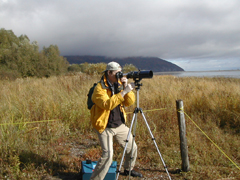Protecting habitat for wildlife and birds: approach
Establishing Protected Areas
Introduction

The planning and establishment of Environment and Climate Change Canada's protected areas is a four-step process. Grounded in science, the process assesses lands and waters based on their ecological importance for migratory birds and wildlife.
Based on these areas’ history of use and their cultural value, Aboriginal traditional knowledge and the role that Aboriginal peoples would play in managing the areas must also be considered, especially in northern Canada. Furthermore, existing land claims agreements and Aboriginal treaty rights need to be respected.
Ultimately, planning and establishing Environment and Climate Change Canada’s protected areas is conducted in close collaboration with other federal departments, provinces, territories, Aboriginal peoples, non-governmental organizations, and individuals. This coordination is jointly conducted by headquarters and the regional offices of the Canadian Wildlife Service; however, headquarters leads the coordination with protected area programming of other federal departments, primarily through its involvement with, the Canadian Parks Council (CPC) and Canadian Council on Ecological Areas (CCEA).
A Four-Step Process
Step 1: Site Identification and Selection
The establishment of protected areas begins with the identification and selection of habitat areas of national importance, the protection of which would directly benefit one or more migratory bird populations, species at risk, or other wildlife species. This is a regionally led process involving coordination with other departments, governments, Aboriginal peoples, and stakeholders that have interests in the potential protected area. The process includes a series of secondary steps that will help delineate the candidate site based on established biological criteria and determine whether it should be designated as a National Wildlife Area or Migratory Bird Sanctuary.
Step 2: Feasibility Assessment
The second step is to conduct a series of feasibility assessments. These include an ecosystem assessment and a strategic environmental assessment, to evaluate the environmental condition of the candidate site and the impact that the potential new protected area could have on the environment and society. In addition, public and stakeholder consultations are conducted to determine the feasibility of turning a candidate site into a protected area. The results of these ecological, social and economic assessments will help determine the boundaries and the various options available for protection, in accordance with the ownership and jurisdiction of the land and aquatic area targeted.
Step 3: Securement & Agreement
Once a candidate site is selected, the type of protected area will determine the instruments available for securing lands and waters. For example, lands for National Wildlife Areas must be federal lands that can be secured through purchase, donation or transfer, while lands for Migratory Bird Sanctuaries can be private, provincial, territorial or federal and can be secured by agreement, easement, purchase or transfer.
Step 4: Regulatory Process
The last step in the establishment of a protected area is based in legislation. For the designation or modification of any of Environment and Climate Change Canada’s protected areas, the related regulation must be amended. This is achieved through thorough planning and preparation that entail various requirements, such as consultations to be held with all stakeholders who could be affected by the designation of the protected area. The regulatory process usually takes a minimum of one year to be completed.
Currently, Environment and Climate Change Canada is pursuing the establishment of the first candidate National Wildlife Area to protect solely marine habitat: the candidate Scott Islands National Wildlife Area off the west coast of British Columbia.
Changing the Status of a Protected Area

In some cases, Environment and Climate Change Canada might consider a change of status for one of its protected areas. The process and criteria to change the status of a Migratory Bird Sanctuary is the same tas that to change the status of a National Wildlife Area. The criteria for determining if such change is warranted, including whether a site should be proposed for delisting, are as follows:
If the selection criteria for the original designation continue to be met, the protected area will not be proposed for delistingFootnote1.
A change in status from Migratory Bird Sanctuary to National Wildlife Area, or from a National Wildlife Area to a Migratory Bird Sanctuary, may be considered provided that the selection criteria for the new designation are met.
The management plan for a protected area whose status has changed from Migratory Bird Sanctuary to National Wildlife Area should maintain the Sanctuary requirements of migratory birds if those requirements remain biologically important.
Local community adoption of and identification with a site must be taken into account. Local and Aboriginal communities may place considerable importance on the protected area within or near their community. This importance may increase over time as development in the area of such communities may alter, disturb or destroy natural areas outside of the protected area. Any recommendation to delist a Migratory Bird Sanctuary or National Wildlife Area should take into account the socio-economic and traditional importance of the area to the local or Aboriginal community.